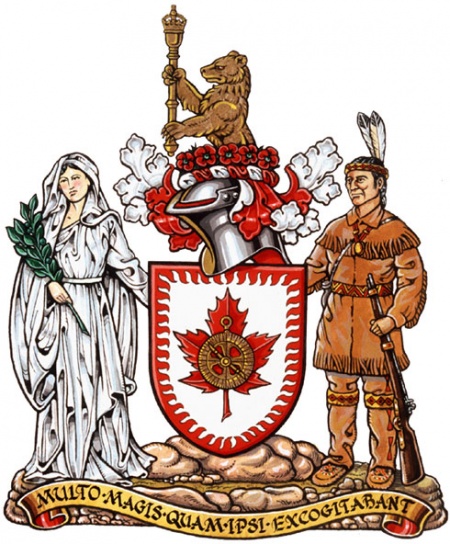Dominion Institute
| Heraldry of the World |
| Canada heraldry portal Civic heraldry of Canada Armorial Canadienne |
|
DOMINION INSTITUTE
Official blazon
Arms : Argent within a bordure rayonné a maple leaf Gules charged with an astrolabe Or
Crest : Issuant from a circlet of poppy flowers proper, a demi bear grasping in its paws a parliamentary mace Or
Supporters : Dexter an allegorical figure for Canada holding in the dexter hand a branch of laurel, sinister a Shawnee warrior tempore 1812 holding in the sinister hand a gun, both standing on a rocky compartment proper
Motto: MULTO MAGIS QUAM IPSI EXCOGITABANT
Origin/meaning
The arms were officially granted on April 3, 2002.
The main colours, red and white, are the colours of Canada, and the maple leaf indicates the centrality of Canadian studies in the Institute’s mandate. The leaf is depicted in a natural form, like the present emblem of the Institute. The bordure is not only a dramatic complement to the jagged edges of the leaf, but it also refers to flames as a traditional symbol of education, a key element of the Institute’s mandate. The astrolabe represents, on one level, the early European explorers, and, on a more symbolic level, intellectual exploration that the Institute encourages.
The poppies are a traditional symbol of remembrance of those fallen in wartime, and a particular reference to the poem “In Flanders’ Fields” by John McCrae. The bear is an animal native to Canada. Mediaeval legend had it that bears literally shaped their young, and this therefore provides a metaphor for the Institute’s role in the intellectual formation of the young people of Canada. The mace refers to Canada’s parliamentary heritage, and highlights the Institute’s purpose in raising awareness of our governing institutions.
The rocky ground is indicative of the Canadian shield, an important geographical feature of the country. The woman refers to the allegorical figure of Canada found on the Vimy monument in France, and thus refers to a defining moment in Canadian history. The Shawnee warrior also refers to an event from Canada’s military past, the War of 1812, in which Canadians drew together to defend themselves. This figure highlights the role the Native people of Canada have played in our history.
The motto is a Latin translation of a phrase on a plaque in Government House, Charlottetown. The original phrase was “They builded better than they knew,” referring to the fact that, because of the efforts of the Fathers of Confederation, Canada grew into a greater country than they could have imagined. By extension, the “they” can also refer to Canadian men and women who worked and made sacrifices for their country over the years. The Institute is committed to making Canadians aware of these past achievements.
Contact and Support
Partners:
Your logo here ?
Contact us
© since 1995, Heraldry of the World, Ralf Hartemink 
Index of the site
Literature: Image and information from http://www.gg.ca












